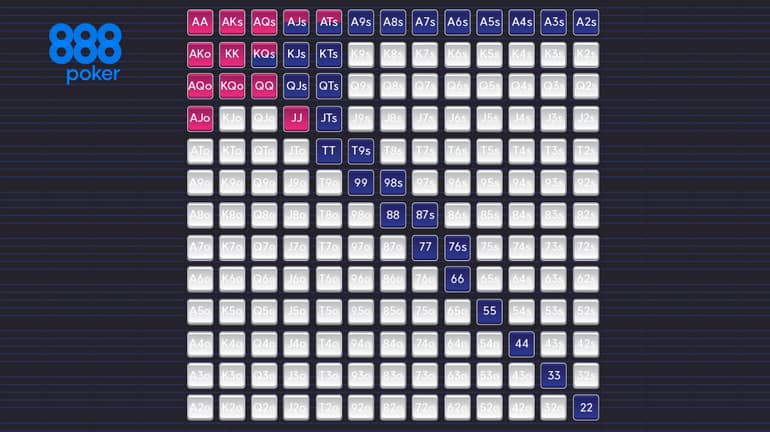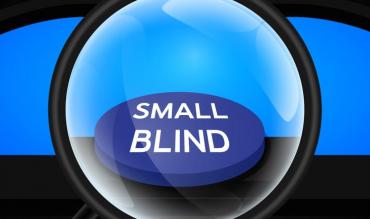Small Blind Guide - Overview
An Introduction to the Small Blind
The Small Blind (SB) located one seat to the right of the Big Blind (BB) and costs at half the cost of the Big Blind.
It is one of the trickiest positions to play at the poker tables. Not playing well in this position can have a noticeable impact on our overall earnings.
Many players would significantly boost their bottom line if they only knew more about this commonly misunderstood position!
Fear not! Pay careful attention to the following article. You’ll learn how to boost your effectiveness when playing out of the Small Blind.
What is the Small Blind Anyway?
The Small Blind is the position directly to the left of the button. It is commonly abbreviated with the letters SB.
| The Small Blind is the position directly to the left of the button. |
Players are required to make a mandatory investment of chips (known as the “small blind”) before any cards are dealt.
SMALL: It’s called “small” to differentiate it from the “big blind” . The BB is an even larger preflop payment made by the player in the BB.
BLIND: It’s called “blind” because players must invest an amount of chips before seeing their hole cards.
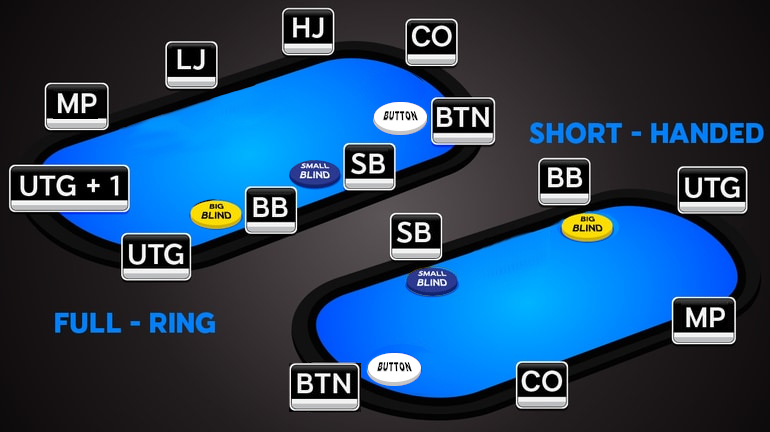
How Much Does the Small Blind Pay?
Depending on the local rules of the game being played, the SB will usually be required to invest half of a big-blind.
So, in a $1/$2 No Limit Hold’em game, the SB will typically invest $1 before seeing any cards. While the BB will need to invest $2 (a full big-blind).
|
Note that the terms “small-blind” and “big-blind” refer to -
Don’t let it confuse you. It’s not too difficult once we get used to it. |
The SB payment is not always exactly half of the BB. It’s even possible in some casinos that the SB payment might be the same as the BB payment. But this setup is usually the exception rather than the rule.
If the action is folded around to the preflop, SB has the option to either –
“raise” or “call”
‘- which is commonly known as “limping” or “completing”.
The SB does not have the option to check. He must at least match the BB amount to continue in the hand.
What About Heads Up?
Remember the following:
| The SB is the same position as the Button (BTN) when playing heads up. |
This fact sometimes causes confusion for players . It means the SB will be in position (act last) postflop. This rule is different from a ring game.
In those scenarios, the SB will always be out of position (act first) postflop.
In most, cases the SB isreferred to as the Button in the context of a heads-up match. So,the Button pays the mandatory small blind preflop when playing heads-up.
|
The Button pays the mandatory small blind investment preflop when playing a heads-up match. |
Ok, now we have the absolute basics out of the way. Let’s launch into the strategy section of our guide. Time to learn how we can boost our SB winrate.
Small Blind Strategy Guide
This basic guide is essential for our strategic outlook when playing in the SB (small blind). We’ll select examples from NLHE cash games, but many of the concepts will translate into other formats such as tournaments or PLO.
Let’s recap on the key features of the SB (small blind).
- We are forced to invest the small blind (usually 0.5bb) before seeing our hole cards.
- The BB (Big Blind) is still to act after us preflop, he may overcall or squeeze vs our cold calls.
- We act second to last preflop but will always be out of position postflop.
- If all players fold to us, we have an excellent steal opportunity.
The Small Blind – An Overview
The fact that we have to invest 0.5bb (depending on the casino) without seeing our hole cards is a significant disadvantage. It does, however, mean we get an effective discount on any preflop cold call. For example, if we face a 3bb open raise, we only need to invest an additional 2.5bb to see the flop.
Steal – An open raise made from the SB (small blind), CO (cutoff) or BTN (button).
A late position open is referred to as a “steal attempt”, due to the excellent chance to win the blind payments without needing to see a flop.
The SB makes a successful steal, if the BB folds facing a SB openraise.
It is not all bad news, however. The most profitable SB scenario is when the action gets folded around to us preflop. Here we find ourselves with an excellent opportunity to pick up the pot preflop; if the BB folds against our open raise, we’ll win the blinds outright. Unfortunately, this is not enough to incentivise wide cold calling strategies in the SB. Why not? The problem is that we have the BB still to act behind us. If we try to take advantage of our discounted cold-calling opportunity to liberally, we leave ourselves open to squeezes and overcalls from the BB. We are forced into playing very tight ranges when facing opens.
Unfortunately, we’ll still find ourselves out of position if the BB decides to give us action, so the SB steal spot is not as powerful as the BTN steal spot. However, looking to steal with a wide range from the SB is an excellent way to boost SB winrate.
If we were to summarise our strategic outlook while in the SB, it would hence be as follows:
Strategic Outlook in the SB
We play extremely tight ranges when facing opens. However, if it’s folded around to us, we steal aggressively.
Stats:
Recommended average cold call frequency: Around 7%
Recommended average 3bet frequency: Around 8%
Recommended raise first in frequency: Around 36%
Sample Ranges From the SMALL BLIND
Let’s take a look at some sample defending ranges from the small blind when playing a 100bb NLHE cash game. Remembering precise combinations is not essential, but we should have a good general feel for how wide we go in each spot.
SB Defence vs BTN Open
Purple: Re-raise (3bet) range
Blue: Cold Calling range
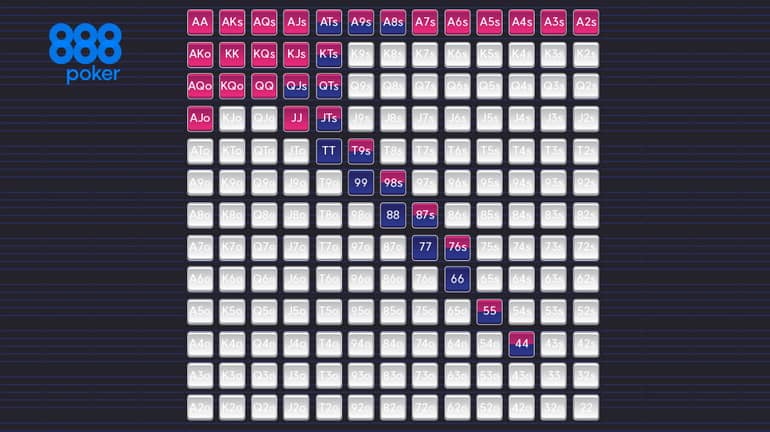
This sample range is for defending against a 3bb BTN open raise. If the BTN open-raises smaller, we should defend wider. Note that the cold-calling range is very narrow here. Many players even prefer to entirely avoid cold calling in the SB and either 3bet or fold when facing an open.
SB Defense vs Lojack Open
Purple: Re-raise (3bet) range
Blue: Cold calling range
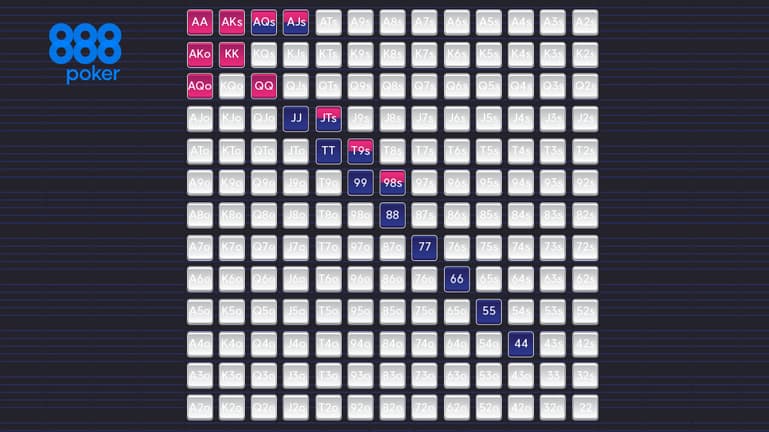
The critical difference should be readily apparent. We protect a tighter range of holdings from the SB when facing an open from an earlier position.
SB Raise-First-InRange
“Raise-first-in” means to open-raise preflop after it gets folded around to us. We have already mentioned that this provides us with a great steal opportunity when we are in the SB.
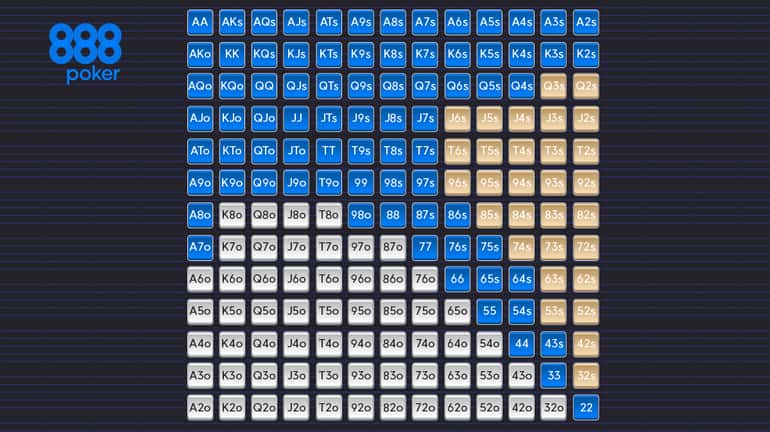
This raising range works out at about 36% of holdings. We raise aggressively with the hopes of picking up the blinds, but we have limits to how wide we can go. If we attempt to open-raise too aggressively, this is something that a strong opponent in the BB can exploit.
SB vs BB 3bet
If we are stealing aggressively from the SB, we are going to run into BB re-raises (3bets) from time to time. The following sample range gives us an idea regarding what we should call and what we should re-raise (4bet).
Blue = Call vs 3bet
Purple = Re-raise (4bet) vs 3bet
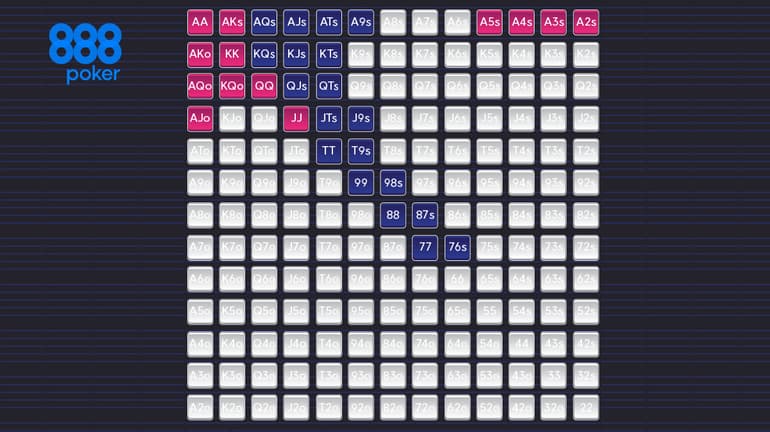
Note that we tend towards re-raise (4betting) with high-equity hands only. 4bet bluffing is not incentivised in most environments since the average villain does not fold as much as they are supposed to vs 4bets.
Relevant Adjustments
It’s essential to understand that the sample ranges should be used as a rough guide rather than a set rule. In practice, we will end up changing these defending ranges based on several variables.
A good understanding of these variables will help us to make high-quality decisions on the fly.
Villain’s sizing – The larger our opponent’s open-raise or 3bet sizing, the tighter we defend.
Formation – The later our opponent’s position, the wider we can defend.
Reads – E.g. our opponent folds too much to 3bets, we can 3bet more aggressively.
Villain skill - If our opponent is a bad player, we can play more hands, in general. We can steal wider from the small blind and/or think about incorporating a range of hands that completes (limps) in the SB.
Steals – If our opponent in the BB folds too much, we can open raise wider, sometimes any two cards.
Cold-calls –If the BB is tight and rarely squeezes, we can get away with cold calling more hands in the SB.
Other Scenarios
Iso-Raising – This situation is where we raise from the SB when facing an open-limp. Seeing as we are always going to be out of position if our iso raise gets called, we should stick to iso raising premium holdings.
However, this does not mean we have to play a tight range of holdings here in general. Many speculative hands can be completed (limped) in the SB when facing an open limp.
Iso-raise – A preflop raise made against a limper.
Light red – Iso raise (SB)
Light blue – Complete facing an open limp
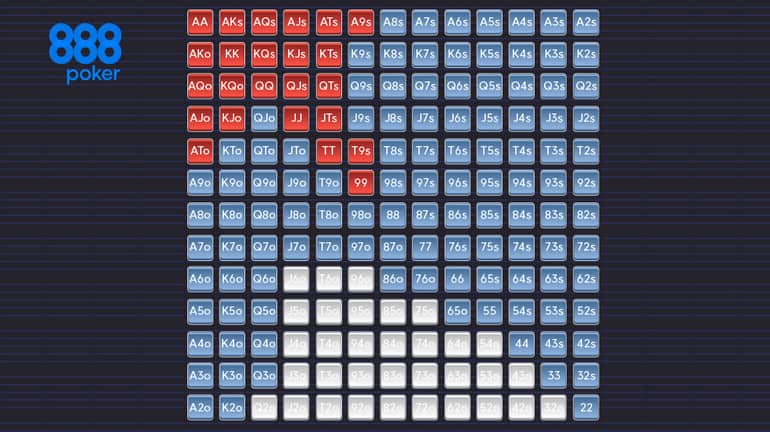
Overcalling/Squeezing – Overcalling and squeezing are terms which refer to 3-way scenarios. When facing two opponents, we generally prefer to 3bet(squeeze) a tighter range and weight our calls (overcalls) towards speculative hands with good suited/connected potential.
Overcall – A call after a player has already called before us on the current street.
Squeeze – A 3bet made after there has already been at least one caller vs an open raise.
For the sake of comparison here is what a SB squeezing/overcalling range might look like when facing a CO open and a BTN call.
Purple: Re-raise (squeeze) range
Blue: Overcalling range
